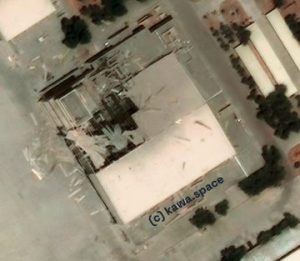Indian air strikes cripple six Pakistan airbases, says analysis

New Delhi: Indian airstrikes Saturday caused significant damage to at least six Pakistani airfields, destroying runways and structures in what analysts say were the most extensive attacks by India in decades of tension with its neighbor.
A visual analysis conducted by The Washington Post using more than two dozen satellite images and aftermath videos found that the strikes heavily damaged three aircraft hangars, two runways and two mobile air force structures. Some of the targets were located as deep as 100 miles inside Pakistan.
“This marks the most extensive Indian air attacks on Pakistani military infrastructure since the 1971 war,” said Walter Ladwig, a senior lecturer in international relations at King’s College London and an expert on South Asian security.
According to geospatial analyst William Goodhind, the strikes targeted high-profile sites in an attempt to “severely degrade Pakistan’s offensive and defensive air capabilities.”
Jeffrey Lewis, director of the East Asia nonproliferation program at Middlebury College, said the bases “suffered some damage, but not of the sort that would disable them.”
India claimed it struck 11 Pakistani bases, calling the operation “measured” and “calibrated.” The Post confirmed damage at several of those sites.
Pakistan’s chief military spokesperson, Lt. Gen. Ahmed Sharif Chaudhry, initially acknowledged infrastructure damage but did not specify how many sites were hit. Wednesday, the military confirmed six deaths within the air force and hits on five military bases and one civilian airport. Chaudhry also claimed that most Indian missiles were intercepted but conceded, “A few managed to sneak in.”
“The satellite evidence is consistent with the claim that the Indian military inflicted meaningful — though in my view not devastating — damage on the Pakistan air force at a number of bases across eastern Pakistan,” said Christopher Clary, an associate professor at the University at Albany.
The strikes prompted swift retaliation from Pakistan, which said it launched counterstrikes targeting military sites in Indian-administered Kashmir and in the Indian state of Punjab. India has denied or refused to confirm any losses.
Pakistan also claimed to have shot down five Indian warplanes during the initial wave of strikes May 7. India has not publicly commented, but The Post analysis indicated that at least two Indian fighter jets crashed during the operation.
The escalation raised alarms in Washington, where officials feared the nuclear-armed rivals were on the brink of war. A cease-fire was announced hours later by then-President Donald Trump.
Indian Prime Minister Narendra Modi later stated that India had “paused” operations but remained prepared to strike again in the event of another militant attack like the April 22 blast in Indian-administered Kashmir, which killed 26 civilians. India blamed the attack on Pakistan, a claim Islamabad denied, calling for an international probe.
Among the damaged sites was Nur Khan air base near Rawalpindi, a key transport hub for Pakistan’s military and located near the Strategic Plans Division, which oversees the country’s 170 nuclear warheads. Satellite imagery reviewed by Goodhind showed that two mobile control centres at the base were destroyed, with smoke visible from nearby areas.
In Rawalpindi, which also houses Pakistan’s General Headquarters and Joint Staff Headquarters, the strike raised concerns about the potential targeting of central command facilities. A military source speaking anonymously said the attack “could have been mistaken as an attempt to destroy the control centre of the country.”
At the Bholari air base, a hangar that typically houses a Saab 2000 airborne early warning aircraft suffered a missile strike, with a 60-foot-wide hole visible in its roof. It remains unclear whether the aircraft was present during the attack.
At Shahbaz air base, used exclusively by the military, another hangar sustained a 100-foot-wide hole, and the control tower was damaged. Satellite imagery also showed collapsed structures at Sukkur Airport, which serves both civilian and military purposes. An apparent radar site was also destroyed.
Large craters were visible on the runways at Mushaf air base and Sheikh Zayed International Airport. At Mushaf, the craters were being repaired the next day, according to satellite images.
Pakistan confirmed five air force personnel were killed at Bholari and one at Mushaf.
Pakistan’s English-language newspaper Dawn reported that the Royal Lounge at Sheikh Zayed airport, named after the UAE’s founder, was also significantly damaged.
“This operation marks a deliberate shift,” said Ladwig, noting that India’s previous military responses were largely confined to Kashmir or remote areas in Pakistan. “Now, India is treating terrorist attacks as grounds for conventional military reprisals.”
PNN
News